Trees Birds Mammals Fish Amphibians Reptiles
Wild Algarve
Bookshop
Marasmius bulliardii Quél.
Phylum: Basidiomycota - Class: Agaricomycetes - Order: Agaricales - Family: Marasmiaceae
Distribution - Taxonomic History - Etymology - Identification - Culinary Notes - Reference Sources
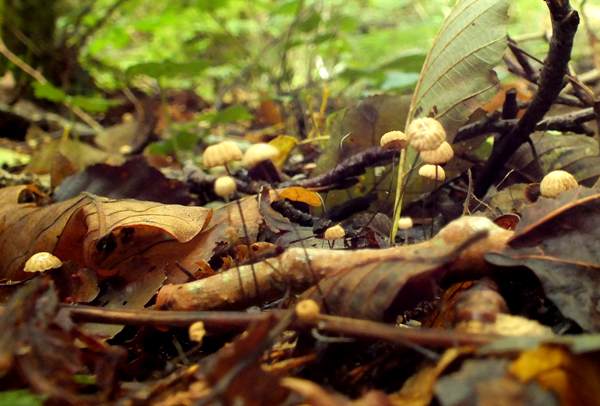
Marasmius bulliardii is an uncommon find in Britain and Ireland, but that may well be largely due to its diminutive size – usually no more than 8mm in cap diameter and often only half that size. You can sometimes find these distinctive little mushrooms in hedgerows, but generally the best places to look are under mature trees in damp, shaded deciduous woodland settings.
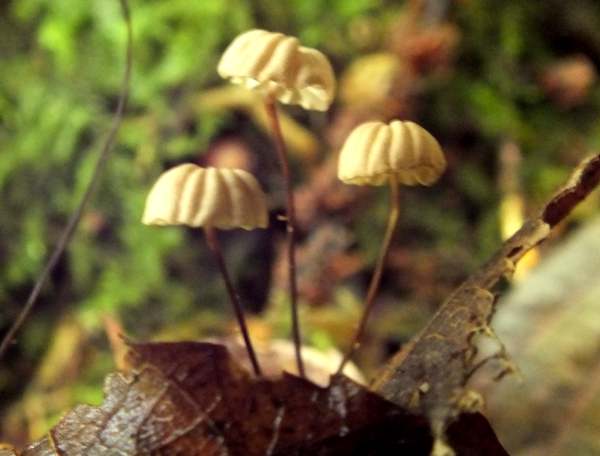
Distribution
Widespread throughout Britain and Ireland but only recorded very occasionally, Marasmius bulliardii occurs in many parts of western and northern mainland Europe, where it is generally an uncommon find but may be locally abundant.
Taxonomic history
This mushroom was described in 1878 by Lucien Quélet, who named it Marasmius bulliardii.
Synonyms of Marasmius bulliardii include Androsaceus bulliardii (Quél.) Pat., Chamaeceras bulliardii (Quél.) Kuntze and Marasmius rotula f. acicola S. Lundell.
Etymology
The genus name Marasmius comes from the Greek word marasmos, meaning 'drying out'. Elias Magnus Fries, who separated the Marasmius genus from the similar white-spored Collybia fungi, used as a key differentiating factor the ability of Marasmius mushrooms to recover if rehydrated after drying out. Fries called this drought survival characteristic 'marescence'.
The specific epithet bulliardii honours French mycologist Jean Baptiste Francois Pierre Bulliard.
Identification guide
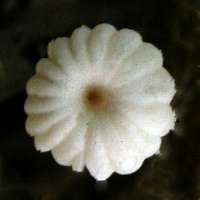 |
Cap
Off-white to pale cream tinged with buff or ochre and 3-10mm in diameter, the parachute-shaped caps of Marasmius bulliardii have deeply-grooved margins. There is nearly always a distinctive dark-brown papilla (nipple) in the centre of each umbilicate cap. |
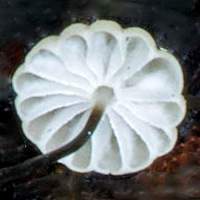 |
Gills
The very distant gills of this parachute mushroom are connected to a collar around the cap stem.
Stem
Near its apex the stem is concolorous with yjr cap, becoming dark brown and then black right down to the base; 0.1 to 0.5mm diameter and 2 to 6cm long. There is no stem ring. |
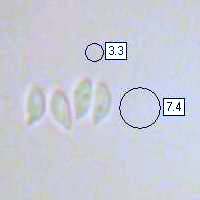 |
Spores
Ellipsoidal to almost cylindrical, smooth, 7.3-9.5 x 3.2-4.5μm, Q ~ 2.1; hyaline; inamyloid.
Spore print
White. |
Odour/taste |
Not distinctive. |
Habitat & Ecological role |
Saprobic, usually in groups, on dead leaves of broadleaf deciduous trees, particularly beech; occasionally also on conifer needles |
Season |
Summer and autumn in Britain and Ireland. |
Similar species |
The main habitat (dead deciduous tree leaf litter) and conspicuous dark centre of its cap help distinguish this little mushroom from the otherwise very similar Collared Parachute Marasmius rotula. |
Culinary Notes
Marasmius bulliardii is so diminutive and insubstantial that any intention to make even a mushroom morsel never mind a meal is quite beyond comprehension.
Reference Sources
Fascinated by Fungi, 2nd Edition, Pat O'Reilly 2016, reprinted by Coch-y-bonddu Books in 2022.
British Mycological Society (2010). English Names for Fungi |
Dictionary of the Fungi; Paul M. Kirk, Paul F. Cannon, David W. Minter and J. A. Stalpers; CABI, 2008
Taxonomic history and synonym information on these pages is drawn from many sources but in particular from the British Mycological Society's GB Checklist of Fungi.
Top of page...
Fascinated by Fungi. Back by popular demand, Pat O'Reilly's best-selling 450-page hardback book is available now. The latest second edition was republished with a sparkling new cover design in September 2022 by Coch-y-Bonddu Books. Full details and copies are available from the publisher's online bookshop...